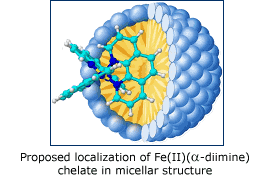Characterization of interfacial phenomena in some systems (micelle, LC phase) is done by using selected organic compounds. The use of inorganic substances, e.g. chelates, for such purpose is limited due to the presence of additional equilibria and conditional stability f(pH, kind of solvent, ionic strength), and due to low parameterization of metal-ligand bonding. On the other hand chelates can be regarded as a group of interesting probes for characterization of interfacial phenomena provided that the applied measuring system is well characterized. Two systems are examined: the first one is based on azo chelates with Cu(I) and Ag(I) and the second is based on chelates of iron(II) with (α-diimine) ligands. In the latter system change of Fe(II)(α-diimine) symmetry from D3 to C2 play the crucial role in characterization of micelar effects, e.g. surface micellar potential.
Research interests are focused on separation of metal ion chelates. This is due to the fact that they are used for the determination of total amount of metal ions, metal ions at various oxidation states as well as for the determination of other compounds, e.g. complementary ligands. The main tools are liquid chromatography and capillary electrophoresis. Among others the method was developed for the separation of chelates of Zr(IV) and Hf(IV), strategically metals, for which there are only a few methods for their determination. Methods based on ternary complexes, due to the enhanced stability of ternary chelates, allows the determination of metal ions (e.g. V, Ti and Ta) as well as determination of additional ligands (e.g. H2O2 or fluoride). It should be pointed out that using the conventional UV-VIS detection the low detection limit for these species (in ppb range) can be obtained. Apart from works devoted the determination of metal ion with the use of chelates are performed systematic studies aiming at estimation of the relationships between separation efficiency of chelates in capillary electrophoresis and their hydrophobicity (as log Pow). The method for the determination of log Pow of chelates was proposed and is in practice.

